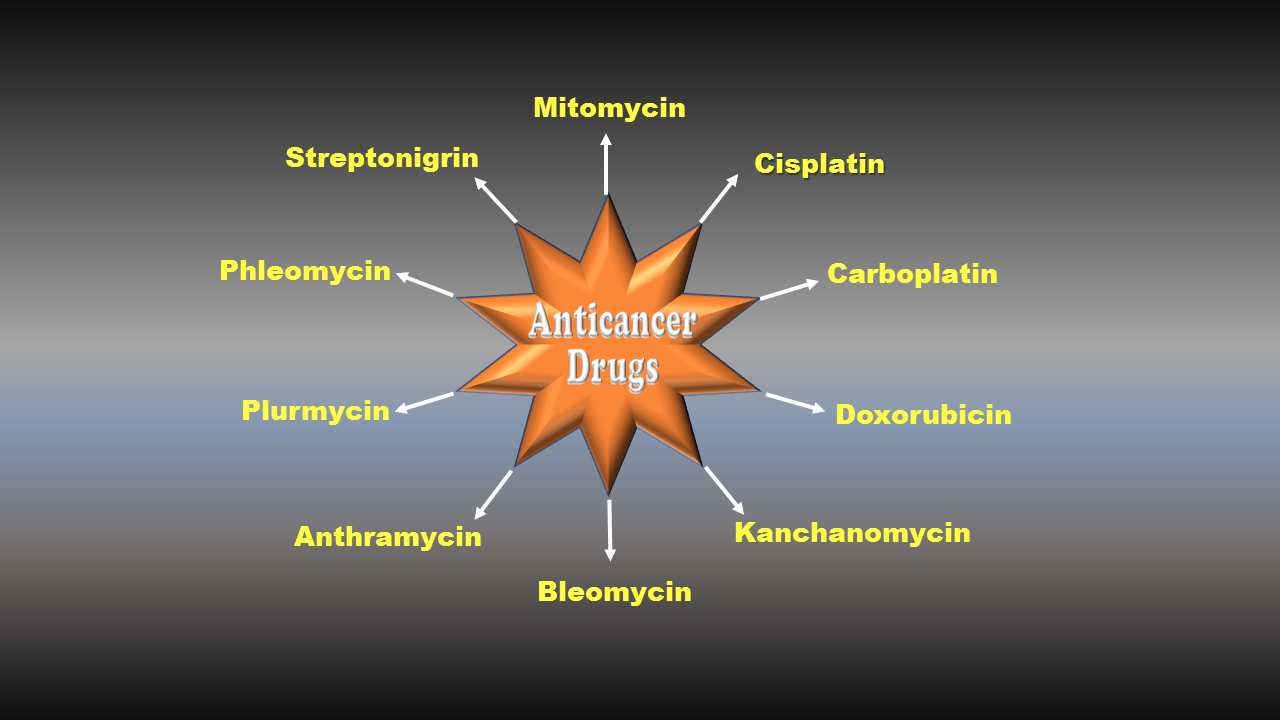Cancer is a type of disease, in which uncontrollable cell growth of an organ or circulatory cells can be recognized, anywhere in the body, if any mutations take place at the gene level. For controlling the cancer disease, the treatment therapies are considering various anticancer drugs which can suppress the uncontrollable growth of cells by interacting with cellular processes.
Numerous anticancer drugs have been isolated from both rainforest plants and microorganisms.
Popular anticancer drugs from bacterial species

Mitomycin
The mitomycin is an alkylating anticancer drug, produced by Streptomyces caespitosus. Mitomycin can covalently bind the DNA molecule and creates cross-links between complementary strands and generates free oxygen radicals, thereby inhibiting the DNA synthesis. The drug has been used to treat upper gastrointestinal cancer, breast cancer, anal cancer, and bladder tumor.
Carboplatin
Carboplatin (Paraplatin) is an alkylating anticancer drug and is used as a chemotherapeutic drug. The drug has the ability to bind and damage both DNA and RNA, thereby inhibiting protein synthesis. The drug can be used to treat various cancers including ovarian cancer, head and neck cancer, brain cancer, lung cancer, and neuroblastoma.
Cisplatin
The alkylating agent Cisplatin is also an anti-cancer chemotherapy drug suggested to treat various types of cancers includes testicular cancer, cervical cancer, bladder cancer, ovarian cancer, and breast cancer, etc. It also has the ability to damage the DNA and RNA and induce apoptosis by activating caspases.
Doxorubicin (DXR)
Doxorubicin (adriamycin and rubex) is an anticancer and antibiotic isolated from Streptomyces peucetius var. caesius. DXR binds between two strands of DNA (intercalating between DNA strands) and also relaxes the topoisomerase complexes by binding to the topoisomerase II enzyme and it resulting in the inhibition of DNA synthesis.
Kanchanomycin
The antibiotic kanchanomycin inhibits the DNA replication by creating complexion with polynucleotides (or DNA) in the presence of a stoichiometric amount of divalent cations Mg2+
Streptonigrin
Streptonigrin is an aminoquinoline antibacterial and antitumor antibiotic produced by Streptomyces flocculus. With the help of divalent cations Zn2+, Streptonigrin interacts with DNA (ssDNA or DS DNA) and then produces reactive oxygen species (free radicals), resulting in the cleavage of DNA.
Phleomycin
Phleomycin is a glycopeptide antibiotic produced from Streptomyces verticillus. This drug has the ability to bind the DNA and cause DNA fragmentation.
Anthramycin
Anthramycin (pyrrolobenzodiazepine) is a broad-spectrum antibiotic isolated from Streptomyces refuineus. This medicine has been used in cancer treatment because it inhibits RNA and DNA synthesis by binding irreversibly with DNA.
Plurmycin family drugs
The antibiotics of the puromycin family produced by fermentation of Streptomyces violaceus show antitumor activity by inhibiting the DNA synthesis.
Bleomycin
The antibiotic bleomycin is a nonribosomal peptide produced by Streptomyces verticillus, which has the ability to break the DNA strand and cleavage of DNA by bleomycin mainly depends on oxygen and metal ions. Some studies suggest bleomycin inhibits DNA synthesis by preventing the incorporation of thymidine into DNA strands. However, the exact mechanism of DNA strand scission is unclear, but it has been stated that bleomycin chelates metal ions (primarily iron) and produces a pseudo enzyme, that reacts with oxygen to produce hydroxide free radicals and superoxide that cleave DNA. The other studies suggested that bleomycin may bind DNA strands at specific sites and creates breaks by abstracting the hydrogen atom from the nucleotide bases.
Dactinomycin
Dactinomycin also called actinomycin D, is a crystalline antibiotic composed of two cyclic peptide chains and phenoxazine chromophore, produced by Streptomyces parvulusis. The drug can be used in chemotherapy medications to treat different cancers. Dactinomycin intercalates (squeezing) between adjacent guanine-cytosine base pairs present in the double standard DNA and inhibits transcription (RNA synthesis) especially during chain elongation, which is more sensitive than initiation and termination. Dactinomycin treatment completely inhibits protein synthesis by inhibiting RNA synthesis, which leads to cell death.
Plicamycin
Plicamycin (Mithracin, Mithramycinum, or Mithramycin) is aureolic acid produced by Streptomyces plicatus. The drug can inhibit RNA and protein synthesis by interacting with DNA. It is used to treat various cancers such as bone cancer and testicular cancer. Plicamycin is also has been recommended to treat hypercalcemia, especially that due to malignancies.
Frequently asked questions
Which of the following best describes the use of rainforest plants as anticancer drugs?
A. Most rainforest plants have been tested for their cancer-fighting properties
B. The most powerful anticancer drugs are not rainforest plants
C. Twenty-five percent of the active ingredients in cancer drugs are exclusively from rainforest plants
D. All of the above
Answer: C ( Twenty-five percent of the active ingredients in cancer drugs are exclusively from rainforest plants).
Dactinomycin is an antitumor drug, that can inhibit RNA synthesis by binding the DNA. However, for the binging of this drug, the polypeptide strand should contain both guanine and cytosine nucleotides. The question is why Dactinomycin drug will not bind to RNA, which also contains both guanine and cytosine in its polypeptide strand?
A. For binding, the drug requires deoxyribose nucleotides.
B. Dactinomycin is only specific to DNA because DNA is longer than RNA
C. Drug intercalates between adjacent guanine-cytosine base pairs present in the double-strand DNA
D. The drug can only bind DNA during transcription because it requires a triplet (RNA and DNA bound region).
Answer: C (Drug intercalates between adjacent guanine-cytosine base pairs present in the double-strand DNA).










